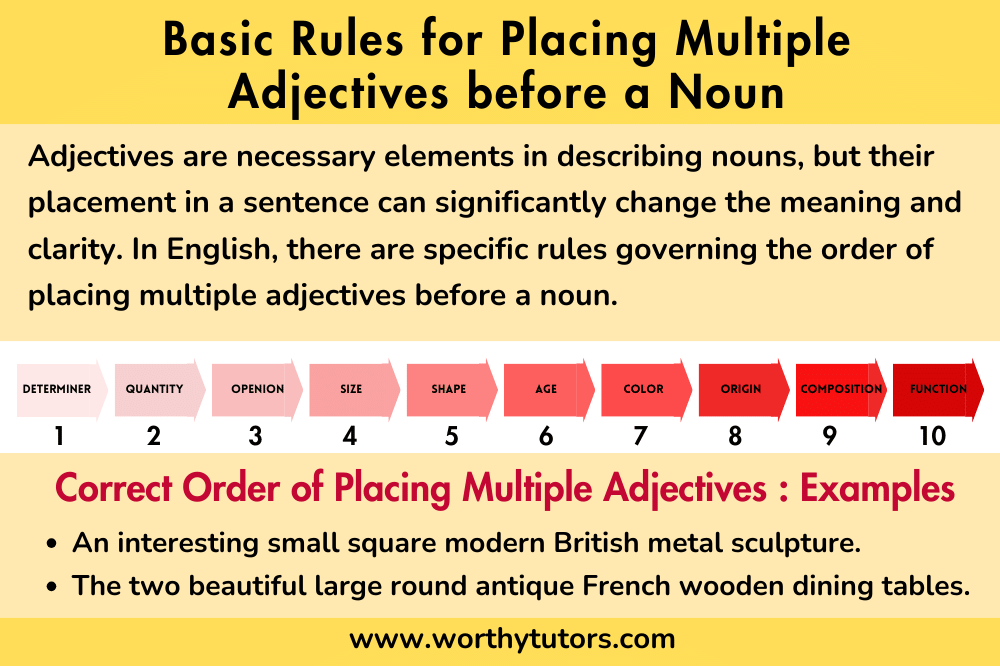
Adjectives are necessary elements in describing nouns, but their placement in a sentence can significantly change the meaning and clarity. In English, there are specific rules governing the order of placing multiple adjectives before a noun. Look at the below example:
Correct Examples of Multiple Adjectives:
- “She wore a long, flowing, red dress to the party.”
- “He bought a sturdy, old, wooden, desk for his study.”
- “They lived in a cozy, little, old cottage by the sea.”
Incorrect Example of Multiple Adjectives:
- “I saw a round, big, white, table.”
- “He found an interesting, wooden, old, chair.”
- “She baked a delicious, chocolate, large, cake.”
Above sentences have multiple adjectives that describes nouns. First three sentences describe the correct order of adjective while next three have an incorrect order of adjectives. Placing adjective in correct order is very significant for keeping the context clear. Understanding these rules is essential for effective communication and clear expression.
Understanding the Basic Rules for Placing Multiple Adjectives
Adjectives typically precede the noun they modify, and their order follows a specific pattern based on various characteristics of the words.In English, adjectives are generally arranged in a specific order that reflects their semantic categories. While there may be some flexibility, adhering to this order ensures coherence and naturalness in expression.
Specific Order of Adjectives
- Determiners such as articles (a, an, the) usually come first before any other adjectives.
- Quantity follows determines to describe the quantity of adjectives.
- Adjectives expressing observations or opinions, such as “beautiful” or “interesting,” follow determiners.
- Adjectives denoting size, like “big” or “small,” come next in the sequence.
- Words describing the shape of an object, such as “round” or “square,” follow size adjectives.
- Adjectives indicating age, such as “old” or “young,” follow shape adjectives.
- Adjectives representing color, like “red” or “blue,” come after age adjectives.
- Adjectives denoting the origin or source of something, such as “Italian” or “Chinese,” follow color adjectives.
- Adjectives describing the material or composition of an object, like “wooden” or “metallic,” come next.
- Adjectives indicating the purpose or function of something, such as “sleeping” or “cooking,” typically appear last in the sequence.
Examples of Correct Order for Placing Adjectives
Below are the examples in which a noun has multiple adjectives in the sentence.
- A beautiful large round antique French wooden dining table.
- An interesting small square modern British metal sculpture.
Exceptions and Flexibility
While the general order of adjectives provides a helpful framework, there are exceptions and instances where flexibility is allowed. Context, emphasis, and stylistic preferences may influence the arrangement of adjectives in specific cases.
Conclusion
Learning correct order of adjectives is essential for clear and effective communication in English. By following the general principles and understanding the specific sequence, writers and speakers can convey descriptions with precision and coherence.
Unique FAQs
Can I change the order of adjectives in a sentence?
While there’s a preferred order, some flexibility exists depending on context and emphasis.
Are there languages with different rules for adjective order?
Yes, different languages may have their own rules governing the placement of adjectives.
Why is the order of adjectives important?
It helps maintain coherence and clarity in descriptions, making communication more effective.
Do all adjectives follow the same order?
While there’s a general sequence, not all adjectives necessarily appear in every description.
How can I practice using the correct order of adjectives?
Engaging in writing exercises and analyzing examples can help using the correct order of adjectives.